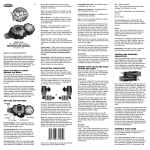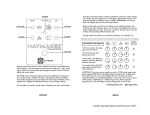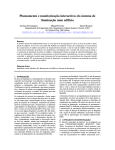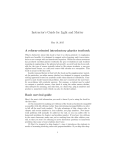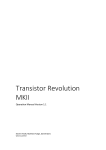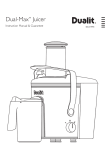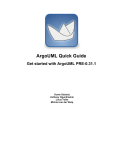Download A Fighting Game of Sorts User Manual
Transcript
Table of Contents Legal Disclaimer................................................................................................................. 2 Minimum System Requirements......................................................................................... 2 System Requirements Note................................................................................................. 2 Installation........................................................................................................................... 2 Controlling the Program ..................................................................................................... 2 Starting the Program ........................................................................................................... 3 Figure 1: The Startup Screen........................................................................................ 3 Character Creation .............................................................................................................. 3 Figure 2: The Character Creation Screen .................................................................... 4 Additional information regarding the various stats ........................................................ 5 Saving the Game ................................................................................................................. 5 Figure 3: The Save Screen ............................................................................................ 6 Combat................................................................................................................................ 6 Figure 4: The Main Screen ........................................................................................... 7 1) Attack.......................................................................................................................... 7 Figure 5: The Attack Screen ....................................................................................... 8 2) Defend ........................................................................................................................ 8 3) Special Move .............................................................................................................. 9 Table 1: EP costs for Energy Combos ...................................................................... 10 Figure 6: The Special Move Screen .......................................................................... 10 4) Power Up .................................................................................................................. 10 1 Legal Disclaimer This game was made solely for academic purposes and may not be distributed, either in whole or in part. Also, Street Fighter and all related material are properties of Capcom Corp, and Dragon Ball/Dragon Ball Z and all related material are properties of FUNimation Corp. Minimum System Requirements Any speed CD-Rom Java Virtual Machine version 1.4.1 (included) Video resolution of 800 x 600 Microsoft Windows 98 or higher 64 Mb of memory 200 MHz CPU System Requirements Note The program should run on any OS that can support the requisite JVM version 1.4.1. However the system was design to run on a Windows system, and as such has only been tested on such systems. In addition, the 800 x 600 resolution is a minimum system requirement, meaning that such a resolution or higher is required for the program to even be playable, but 800 x 600 is also the best resolution to run the program at and therefore is also the recommend resolution. The memory and speed requirements are merely estimates; more memory and higher speeds will lead to an overall better playing experience. Installation First insert the CD. If a 1.4.1 JVM is not installed on the target system, double-click on “j2re1_4_1_01-windows-i586.exe”. This will launch the Java 1.4.1 Windows installation. Make sure to pick an installation directory that does not contain any spaces. Therefore, “Program Files” would not make a good choice as there is a space between the word “Program” and “Files”. Perhaps the best choice is to simply use “C:\j2re1.4.1”. If a 1.4.1 JVM is installed on the target system and/or one has finished installing the 1.4.1 JVM, copy the “FGOS.jar” file from the CD to a directory of your choice. Controlling the Program Throughout the program one will be prompted to make a selection. For the most part everything can be accomplished by simply using the mouse and clicking on the option desired. However, at times the keyboard will be required to enter input, and if one desires the keyboard can be used entirely for input. The Tab key traverses through the available options. Pressing Shift + Tab causes one to traverses backwards through the available options. Pressing the Space Bar selects the currently highlighted option. Also, the first letter of every option is capitalized and underlined. This signifies that pressing Alt + the capitalized and underlined letter is equivalent to clicking that option with the mouse. Although the option is given at various point throughout the program to quit, by pressing the Alt + F4 keys one may quit the program at anytime. However, by using this method any information since the last save will be lost. For additional information about a given option simply leave the mouse hovering over the option in question. After a couple of seconds a tool tip will appear with additional information pertaining to the option. 2 Starting the Program Run the program by double-clicking on the “FGOS.jar” file. The program will launch and bring up the start screen. From there one can either “Start a New Game” or “Continue Existing Game”. The drop down list box is used to select from the available save slots for the purposes of continuing an existing game. Selecting to start a new game leads to the character creation screen. Figure 1: The Startup Screen Character Creation The game itself can be thought of as a die six or D6 system, as all aspects of the game are determined by “rolling” a number of six-sided dice. Characters begin the game with a total of 12-24 Character Creation Points to distribute between strength, endurance, dexterity, speed, skill, and # attacks. The actual number of points is determined by “rolling” five six-sided dice or 5D6, “re-rolling” all 1’s, then discarding the two lowest dice results (or simply two of the lowest results in case of ties), and totaling the results of the remaining three dice and adding six to that result to arrive at the final number. This process is then repeated a total of three times with the highest result used for the CCP total. This of course leads to the absolute minimum of 12 and absolute maximum of 24. However, given the above method the average is (or should be) closer to 22. With whatever amount of Character Creation Points the player has to distribute, he or she buys stat points for his or her character. The character’s strength, endurance, dexterity, speed, # attacks, and skill score all start with a rating of 1. In order to increase a certain stat it costs an amount of Character Creation Points equal to the stats current rating, so to buy a stat from rating 1 to rating 2 would cost 1 point, and to buy a stat from rating 2 to rating 3 would cost 2 points, 3 etc. There is no maximum or minimum imposed on a character’s stats other than the finite number of Character Creation Points and starting score of 1 for each stat. A character’s starting health points is equal to 100 plus N and the roll of N six-sided dice, with N equal to the character’s endurance score. Once again all 1’s are re-rolled. A character’s starting energy points is equal to 33 plus the roll of N six-sided dice. This time N is equal to the character’s skill score, and 1’s are still re-rolled. All characters begin play with a starting power level rating of 0. It can only be permanently increased by progressing through the various stages of the game. After every stage the hero completes, his or her power level goes up by one, all wounds are healed and the hero is fully rejuvenated (i.e. his or her energy points is restored to full). The hero also gains an additional number of health points equal to N plus the roll of N six-sided dice, and a number of additional energy points equal to N. In both cases N is the hero’s (new) permanent power level score, and all 1’s are re-rolled. By the final stage of the game it should not be uncommon for the hero to have accumulated well over 300 health points and 100+ energy points. Also, Character Creation Points can be used to purchase combo attacks. The cost of each combo attack varies and is dependent on how the number of attacks in the combo. A two hit combo cost two Character Creation Points; a three hit combo costs three Character Creation Points, etc. As far as the actual character creation process goes, it is actually very straight forward and quite simple. Simply follow the on screen directions. Extra information about any particular option can be found through the use of tool tips as describe in the section on Controlling the Program. Figure 2: The Character Creation Screen 4 Additional information regarding the various stats: Each stat is used either independently or in combination to determine different aspects of the game. A character’s health points or HP determines the maximum amount of damage that character can take before dying. If the hero’s health points ever drops to or below zero the hero is dead and the game is over. A character’s current number of energy points or EP determines the maximum amount of energy that can be used to fuel the character’s special moves. A character’s current power level influences many aspects of the game. It is added to all damage the character deals and helps in resisting all damage a character receives (with few exceptions). Also at the beginning of every combat round, a character rejuvenates a number of energy points in relation to the character’s current power level. A character’s strength helps in determining the amount of damage the character deals with physical attacks. It rates how strong a given character is. A character’s endurance rating is used to resist damage from attacks, and also helps in determining the number of health points a character begins play with. It rates how tough a given character is. A character’s dexterity rating is used along with the character’s skill rating and power level in determining whether energy attacks hit. They also determine how good a character’s defense is when the character chooses to defend in combat. It rates a given character's reflexes and handeye coordination. A character’s speed rating along with the character’s current power level determines how fast a character moves/reacts. It rates how fast a given character is. In game terms this translates into determining who goes first in any given combat round. A character’s base # attacks along with the character’s current power level determine the number of attacks the character has per combat round. During character creation, # Attacks determines the base number of attacks the hero has. In addition to what was stated earlier, a character’s skill rating along with the character’s strength and power level determine whether a character connects with a physical attack. It also helps in determining the number of energy points a character begins play with. It rates how skilled a martial artist a given character is. Energy Attack Strength helps to determine the damage done by a given character’s energy attacks. Saving the Game At various times throughout the course of the game, you will be given the option of saving the game. Simply select the slot (either slot 1, 2, or 3) one wishes to use from the drop down list box, and select Save Game. 5 Figure 3: The Save Screen Combat The combat system of A Fighting Game of Sorts involves many complex computations. Luckily, all such computations are performed for you by the computer! A basic rundown on the mechanics behind the combat system is described below. At the beginning of every round the character’s speed + current power level is rolled to determine when the character gets to go. Also, the number of attacks a character has is divided into this total to determine how long each attack the character makes is. The same is done for the opponent. During the players turn he or she is presented with a number of options. As depicted in Figure 4: The Main Screen the choices include: attack, defend, use special move, and power up. Each option is describe below in length. 6 Figure 4: The Main Screen 1) Attack Should the character chose to attack then the options use a normal attack or use a power attack is given. A normal attack is just that, a normal physical attack. A power attack is similar to a normal physical attack, except that much more force is put into the blow. A normal attack is determined by rolling a number of six-sided dice equal to the character’s strength + skill + current power level to determine if the character scores a hit. If the opponent has the chance and chooses to defend, the difficulty of the attack is determined by the opponent’s defense roll, which is dexterity + skill + current power level. Otherwise the difficulty is merely the total of opponent’s dexterity + skill + current power level, which should make it fairly easy to score a hit in such cases. The damage a successful normal attack deals is determined by rolling a number of six-sided dice equal to the attacker’s strength + current power level. Afterwards, ¼ of the amount that the attack score beat the defense difficulty is added to the total to simulate the effect of hitting more vital areas of the opponent. This result is resisted by the opponent’s roll of endurance + current power level. If the amount of damage dealt is greater than the opponents resistance roll, the amount of damage the opponent receives can be calculated by subtracting the opponent’s resistance roll from the total damage dealt. If the damage dealt is equal to or less than the opponent’s resistance roll, the attack has managed to hit the opponent, but no damage was dealt. Opting to use a normal attack uses up one of the character’s # attacks for a given round. As stated earlier, a power attack is similar to a normal attack except that much more force is put into the blow. A power attack has minus one die six chance of hitting an opponent, deals 7 damage equal to that of a normal attack + ½ the attacker’s strength score in six-sided dice, and counts as two attacks (i.e. uses up two of the character’s # attacks for a given round). Basically, a power attack is a slower, less accurate, but more powerful normal attack. It is synonymous to a haymaker, whereas a normal attack is synonymous to a jab. Figure 5: The Attack Screen 2) Defend As stated earlier, if a character has the chance and chooses to defend, the difficulty of an attack is determined by the character’s defense roll, which is dexterity + skill + current power level. Otherwise the difficulty is merely the total of character’s dexterity + skill + current power level, which should make it fairly easy to score a hit in such cases. Defending also increases one’s resistance to damage. Normally one resists damage with one’s endurance + current power level in six sided dice (re-rolling one’s), but if one is defending when one gets hit, one uses one’s endurance + current power level and one’s skill in six sided dice (rerolling one’s again) to resist damage. Given the benefits, it is obvious that defending can be extremely useful at times. But what determines if a character has the chance to defend? Lots of factors are involved in determining whether or not the character has a chance to defend. The main determinates are the character’s and his or her opponent’s speed and current power level. 8 3) Use Special Move As stated earlier, during character creation the player is presented with a number of special moves to purchase for the hero. By selecting the Use Special Move option the hero is presented with the option of using one of the special moves he or she knows. Even if no points are used toward the purchase of special moves, every character knows how to perform an energy blast. Conceptually an energy blast can be thought of as a ranged attack, although some energy attacks are actually merely energy imbued physical attacks. The attacker rolls dexterity + skill + current power level to determine the accuracy of the attack. The difficulty of the attack is the same as the difficulty of a normal attack and is determined in the exact same way (see above). The damage dealt by an energy attack is equal to the roll of the energy attack’s basic strength + the attacker’s current power level. To that result is added ¼ of the amount that the attack score beat the defense difficulty and the amount of energy points poured into the blast. An energy attack’s basic strength is determine at character creation time and is dependent on the amount of Character Creation Points spent on increasing its attack strength. As stated earlier all characters know how to perform an energy blast (i.e. all character’s basic energy attack strength is equal to or above 1), some just know how to do it better (i.e. they spent more points in it and their basic energy attack strength is greater than 1). The base cost of an energy attack is equal to the energy strength of the character performing it. Addition EP can be sunk into an energy attack thereby making it more powerful. For each additional EP spent on an energy attack beyond the base cost, that energy attack deal one more point of damage if it hits. The amount of energy points poured into an energy blast is limited by the number of energy points a character is willing and able to spend. There is an obvious benefit from spending a large amount of points, should the blast hit it is nearly guaranteed to deal a significant amount of damage. However, the drawbacks to this course of action are many. Should the attack miss, all that energy was wasted. Also, channeling energy into an energy blast takes time. A character can only channel a number of energy points equal to the roll of his or her energy attack strength + skill + current power level in six sided dice per attack action. Therefore a single energy blast could count as multiple # attacks and take a significant amount of time to complete. And of course, any energy spent on this attack cannot be used for other purposes. Other special moves include multiple hit combos, either physical or energy. There are three basic types of multiple hit combos, x2, x3, and x4. Each corresponds to the number of attacks contained in the combo. A x2 physical attack has a -1 die six chance of hitting, but rolls to hit twice and can therefore potentially deal damage twice. A x3 physical attack has a -2 die six chance of hitting, but rolls to hit three times, and can therefore potentially deal damage three times. A x4 physical attack has a -3 die six chance of hitting, but rolls to hit four, and can therefore potentially deal damage four times. As far as hitting and damaging is concerned physical combos are equivalent to normal physical attacks except where noted above. Also each combo attack costs a number of EP to unleash. A x2 physical costs 4 EP, x3 physical costs 9 EP, and a x4 physical costs 16 EP. Also a x2 combo counts as two attacks, a x3 counts as three attacks, and a x4 counts as 4 attacks. However, each combo attack takes only one action worth of time to actually complete, so they are very fast! The multi-hit energy attack combos function very similarly to their physical counterparts except that the use a normal energy attack as their base form instead of a normal physical attack. 9 Energy attacks also cost more EP because of this fact. The formula for determining the cost of a multi hit energy attack is, as follows: x2 = 4 + 2 x energy attack strength; x3 = 9 + 3 x energy attack strength; x4 = 16 + 4 x energy attack strength. The following table shows this result in greater detail: Energy Strength x2 x3 X4 1 6 12 20 2 8 15 24 3 10 18 28 4 12 21 32 5 14 24 36 6 16 27 40 7 18 30 44 8 20 33 48 9 22 36 52 Table 1: EP Costs for Energy Combos Figure 6: The Special Move Screen 4) Power Up As should be readily apparent by now, one’s power level plays a large part in combat, so the desire to increase one’s power level is understandable, and choosing this combat option is the only way to accomplishes just that other than completing the various stages or cheating. However, while powering up a character is vulnerable to attacks as the character cannot defend and power up at the same time, so one’s difficultly to hit drops to zero. Also, there is a limit to how much a character can safely power up. The maximum amount a character can safely power up is equal to the character’s endurance score. If the character exceeds this amount, then the character takes die damage / round equal to the number levels the character has exceeded his endurance limit. This damage is automatic (i.e. it never misses) and occurs at the beginning of every combat round (at the same time the character is rejuvenating 10 energy points). Also this damage cannot be resisted and may lead to the character’s eventual death. The character may continue to power up, but should the character’s additional power levels ever exceed twice that of his or her endurance score, the character will explode, dealing damage equal to N + N rolls of D6 + the character’s current energy point total. N in this equation is equal to the character’s (new) current power level. This “attack” never misses and has the potential to deal significant amounts of damage to the opponent. Should this “attack” result in the death of the opponent, the match is considered a draw as both opponents have died. This leads to the draw match ending, but the stage is considered a “win” for the hero as far as ranking goes. However, in such a situation the game is still over for the hero as he or she has died. In addition, it is not guaranteed that a character will succeed when he or she attempts to power up. There is a 40% chance one will succeed if the result is within the yellow zone (the zone where the character is not taking damage). A 20% chance one will succeed if the result is within the red zone (the zone where the character is taking damage). And a 10% chance one will succeed if the result would kill you (the white zone). Furthermore, whether a character succeeds in powering up, he or she rejuvenates a number of EP equal to the characters (new) current power level in six sided dice. Also note that the number of attacks it takes to power up is equal to the power level one is attempting to achieve. For example if one is attempting to reach power level 5, it would take five attacks to attempt to power up, during which time one could not defend oneself. Also, once a character powers up, he or she cannot power down until the match is over. It is simply not possible for the character to calm down after having psyched up in the thick of combat. In other words, a character stays power up for the duration of the fight, and returns to his or her normal (permanent) power score after a fight is over. Therefore caution should be taken before powering up past one’s limits. 11














